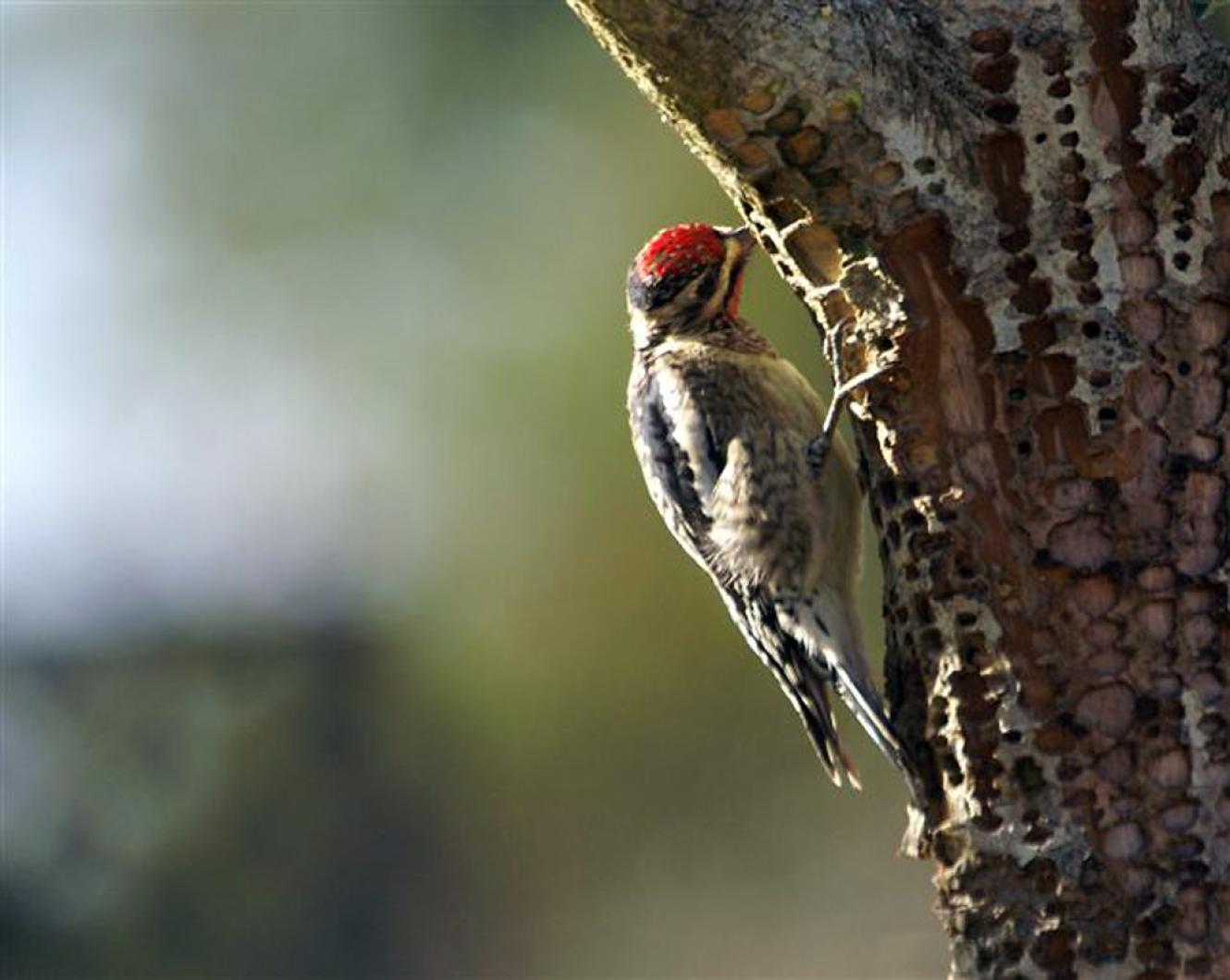There is a Sphyrapicus varius on a holly tree in Luanne Johnson’s North Tisbury yard. No this is not a disease, but a yellow-bellied sapsucker. Sphyrapicus, for translation purposes, is Sphyra (mallet or hammer) and picus (woodpecker), varius (variegated or multicolored). So the sapsucker is a woodpecker with a mallet of a bill sporting various colors. This is indeed a great description of this woodpecker which is a spring and fall migrant and becoming a common winter resident of the Vineyard.
The sapsuckers are blamed for killing the trees into which they drill multiple holes. They probe into the inner bark of trees. Once the holes are drilled they fill with sap much to the sapsuckers delight. With a specially adapted brush-tipped tongue, the sapsucker slurps up this sugary liquid. These sap wells can attract insects which the sapsucker devours and which attract other species of birds.
The best way to find a sapsucker is to look for a tree, usually fruits such as apple or peach, which has rings of quarter-inch-square or round holes up and down the trunk. This is the normal pattern for these woodpeckers. If at first you don’t see the bird, wait a bit, it may be working on the back side of the tree.
Bird Sightings
Thanksgiving enjoyed and past, we turn our thoughts to losing the weight we put on by roaming around looking for winter birds. However, do not forget it is deer season, so wear orange or red and choose your birding spots carefully.
Back on Nov. 11 Dan Greenbaum called with a description of a bird that had, unfortunately, hit his Chilmark window. The details were excellent, the bird a cedar waxwing. The bird hit the window either due to being startled by a hawk or becoming intoxicated eating ripe berries.
Prior to Thanksgiving I received a series of e-mails from Dick Jennings and Rob Bierregaard. The gist of their communications was that two young ospreys reared on the Vineyard have no longer been sending signals from their transmitters. One is Bea from Chappaquiddick and the other Isabel from Tashmoo. Bea quit transmitting from Venezuela on Nov. 3. Isabel’s story is intriguing. She quit transmitting on Sept. 22 but started transmitting again on Nov. 12 52 miles south of where she was last heard from. Rob has contacted a Venezuelan biologist to check out the site of this last transmission and try to determine what is going on. The theory is that the transmitter is on the ground in a position where the sun can charge the batteries and allowing the unit to send signals.
On a lighter side, Caley from Katama, made it out of the Dominican Republic and has moved to Venezuela. Moffett from the Felix Neck nest is sharing Cuba with another fledgling osprey, Ozzie, from the Cape.
Nancy MacMullen of the Cobbler Shop on the Vineyard Haven-Edgartown Road has a perfect feeder set up for red-breasted nuthatches and brown creepers. She has suet on the side of a tree that grows through her porch.
Tom Rivers spotted a black vulture soaring over Tabor House Road on Nov. 20. The West Tisbury Congregational Church had an unusual parishioner on Sunday, Nov. 22 — a yellow-bellied sapsucker. The bird flew around during the service and afterwards Taffy McCarthy closed all the shutters, scattered cracker crumbs in the loft and when the bird landed she was able to put her coat over the bird and gently take it outside and release it. Perhaps this is the same bird that is visiting Luanne Johnson’s North Tisbury holly tree!
At 6:15 a.m. Happy and Steve Spongberg were on their way to the boat when, by Nip ’n Tuck Farm, a screech owl flew across the road in front of them. The Spongbergs missed the owl and caught the boat.
Matt Pelikan walked the Woods Preserve on Nov. 24 and spotted what he considers the usual: brown creeper, hermit thrush, winter wren, tree sparrows, a flock of eastern bluebirds, a couple of grey catbirds and a “mean looking Cooper’s hawk.”
Laurie Walker found two red-necked grebes and two great-blue herons at Menemsha on Nov. 30.
David Stanwood recorded a great horned owl calling down by the dock at Lake street in Tashmoo on Thanksgiving evening. Penny Uhlendorf and Rob Culbert both noted that there is a pair that has been breeding for four seasons on the other side of Lake Tashmoo. This pair fledged one owlet and, as Penny noted, “who-o-o knows where that one’s gone!”
Whit Manter birded Gay Head on Nov. 29 where he found a flock of 18 American goldfinches, 24 dark-eyed juncos, six Carolina wrens and a red-tailed hawk. At Squibnocket Whit added two swamp sparrows and a single meadowlark which he considered might be a western, but due to lack of song he was unable to call it anything but an eastern meadowlark.
Bert Fischer had three red-winged blackbirds and an equal number of tree sparrows at his Aquinnah feeders on Nov. 30. Warren Woessner watched with pleasure as a man feeding the gulls from the top deck on the ferry bound for Woods Hole brought in a black-legged kittiwake. The next day Allan Keith, also on the ferry headed for Woods Hole, spotted nine razorbills and a king eider in with common eiders at the mouth of Vineyard Haven harbor.
Tim and Sheila Baird let me know that the flock of snow buntings is still at the right fork to Katama and the brant are in Oak Bluffs at the Inkwell, no doubt for the winter.
Please report your bird sightings to the bird hotline at 508-627-4299 or e-mail to birds@vineyardgazette.com.
Susan B. Whiting is the co-author of Vineyard Birds 2. She leads bird walks and is retired from Osprey Tours, a company that led birding tours to Latin American for 30 years.




Comments
Comment policy »